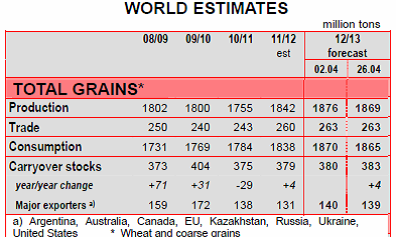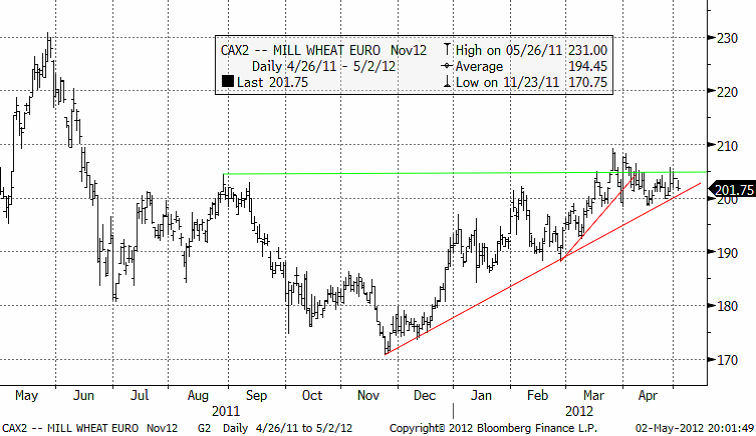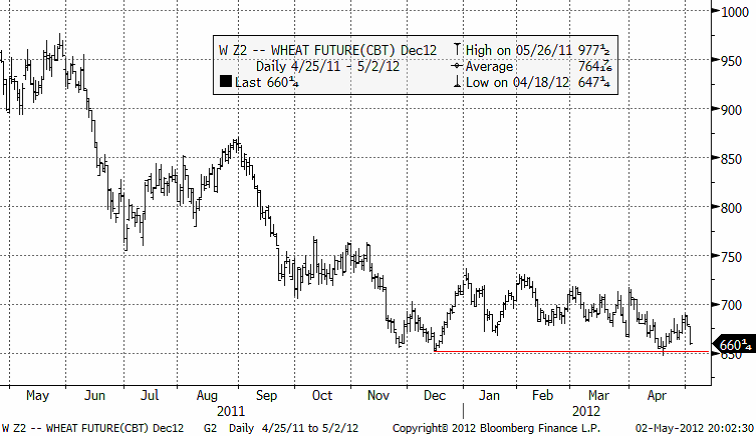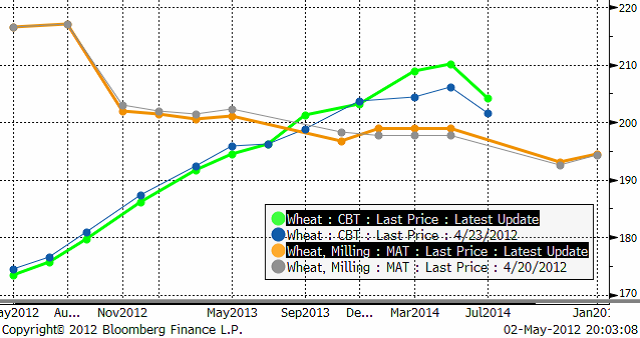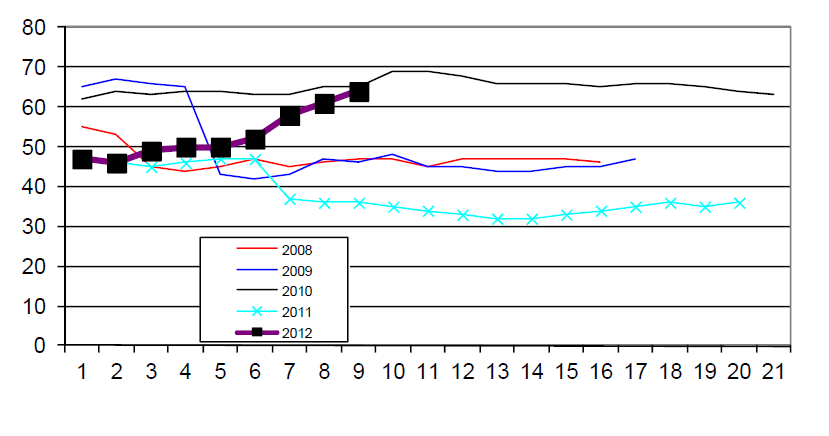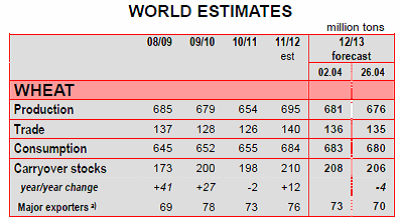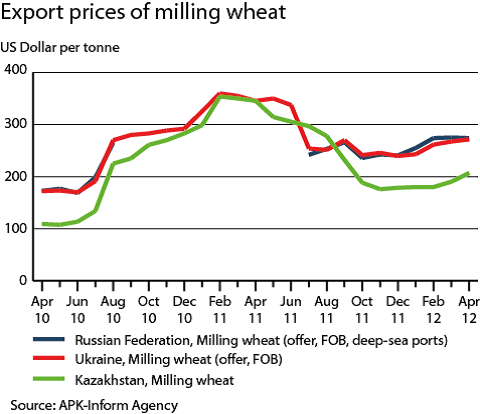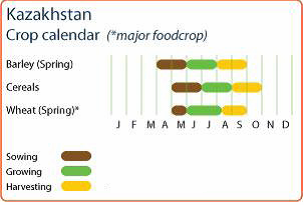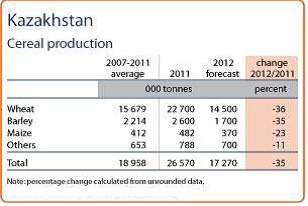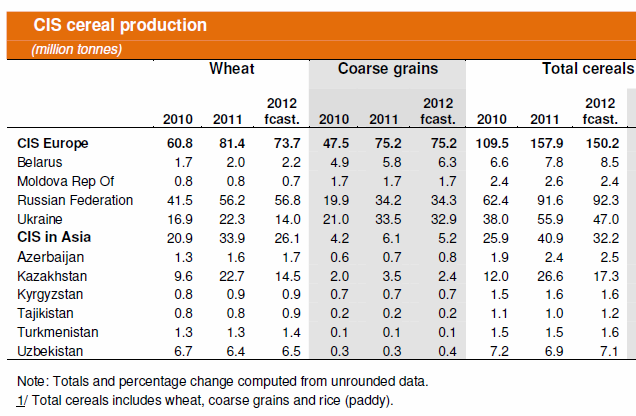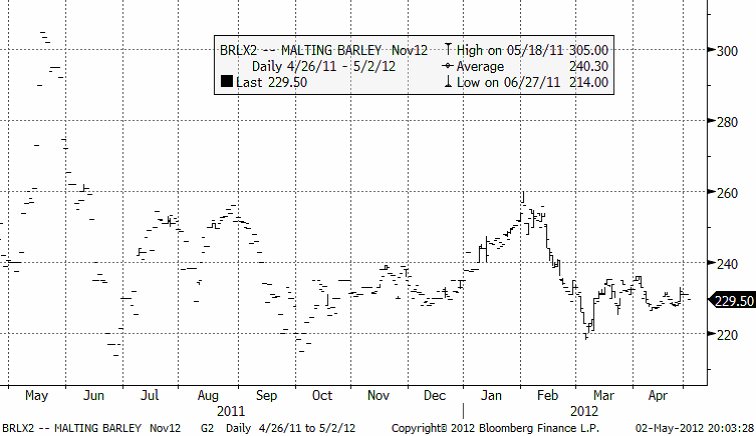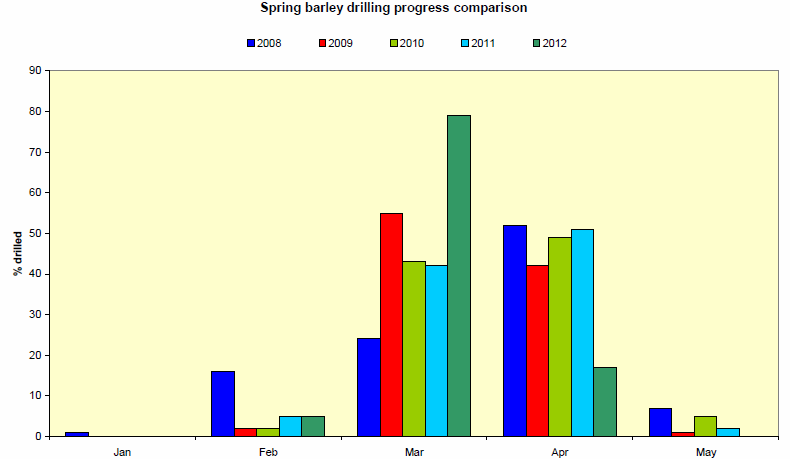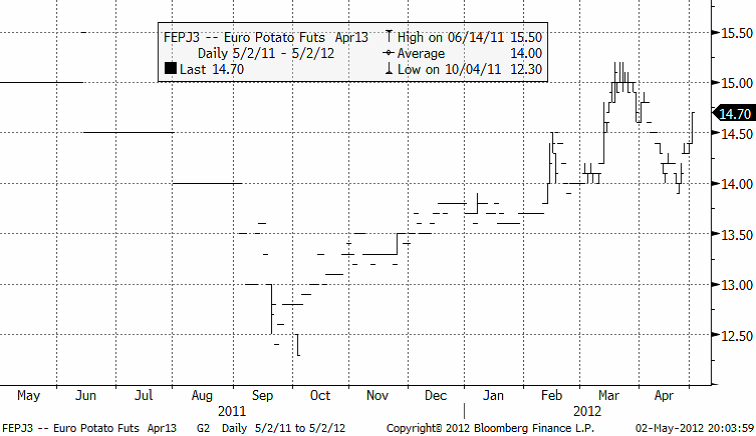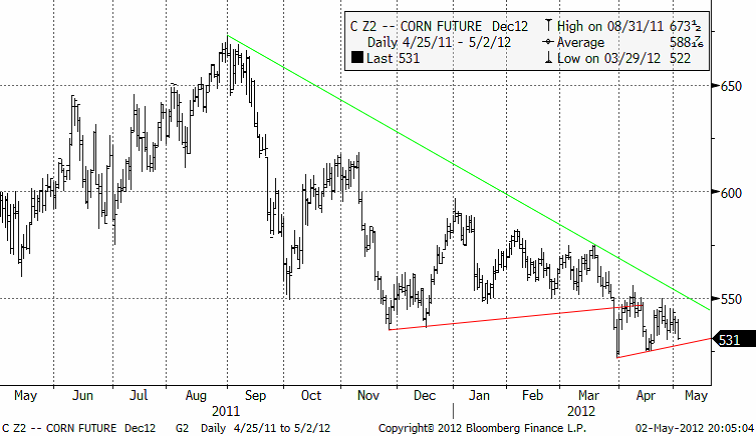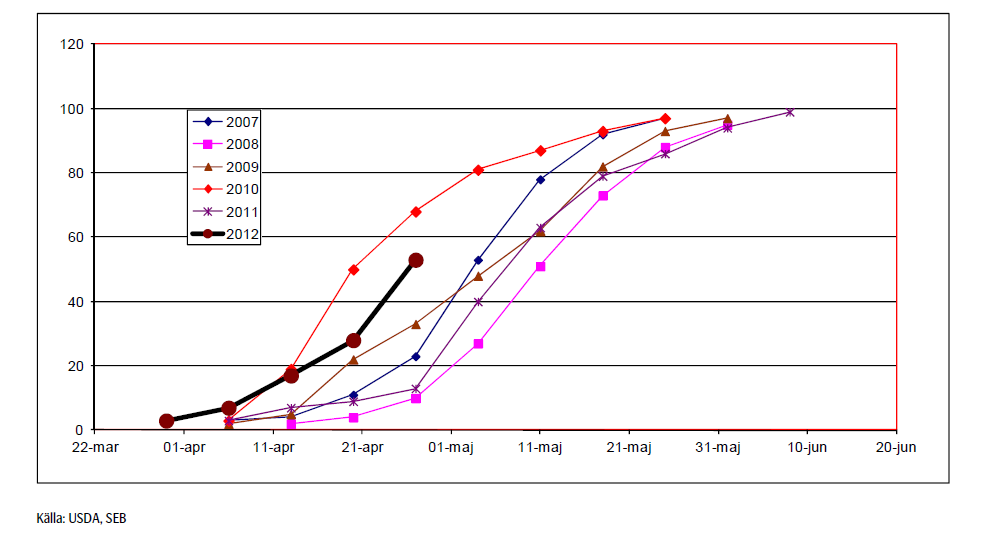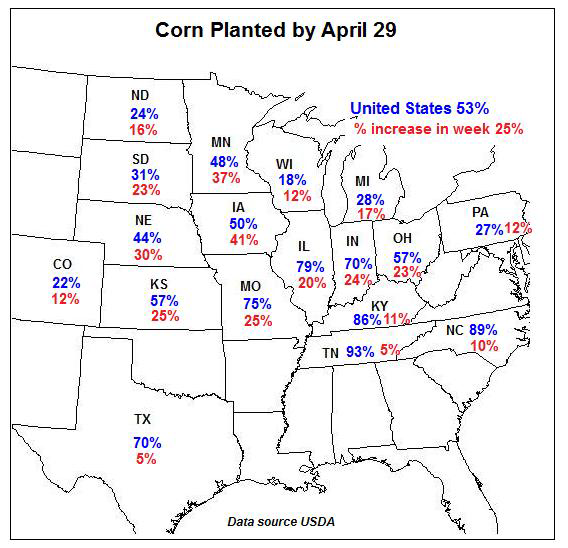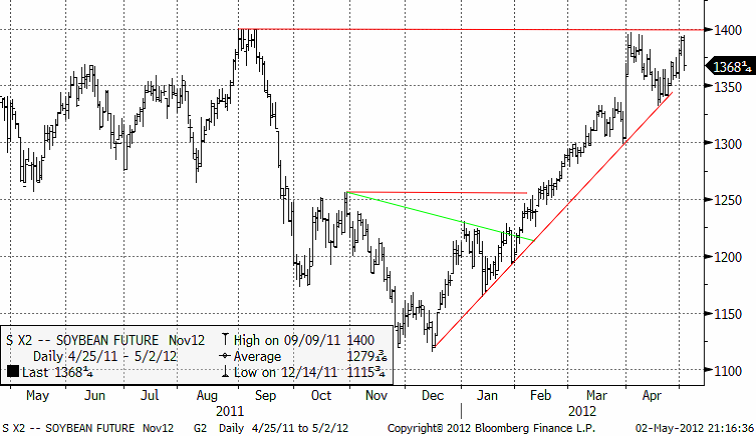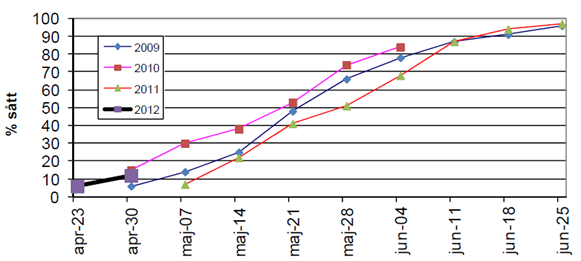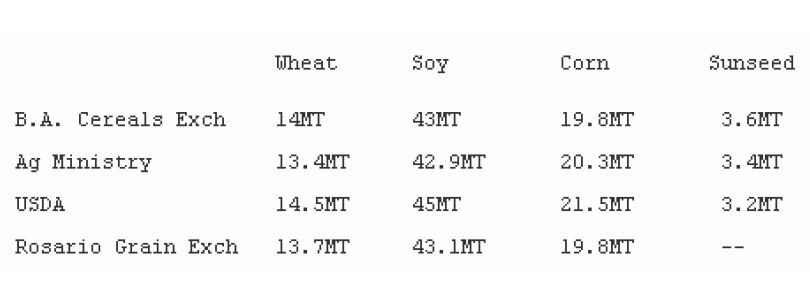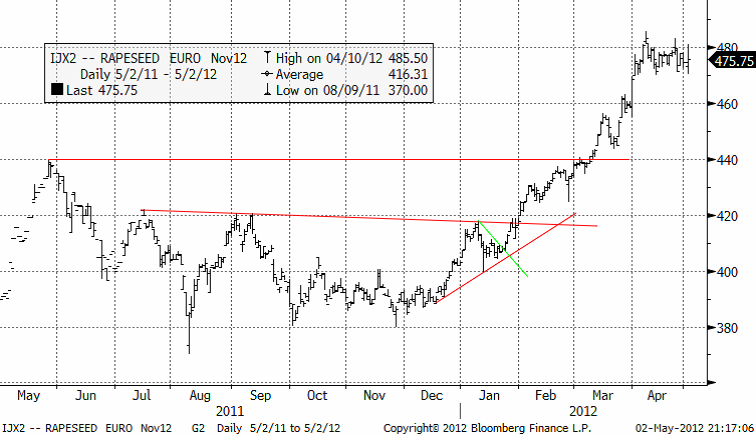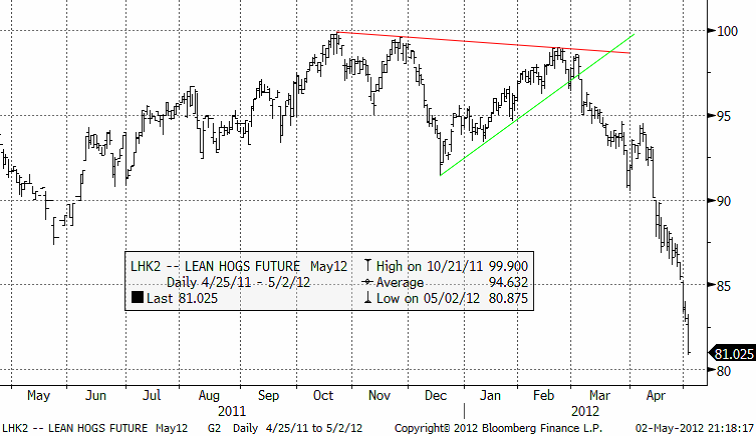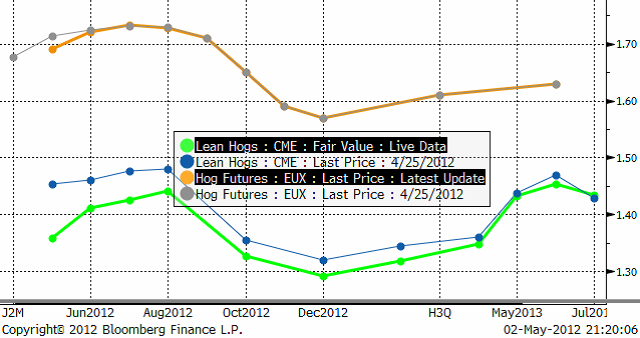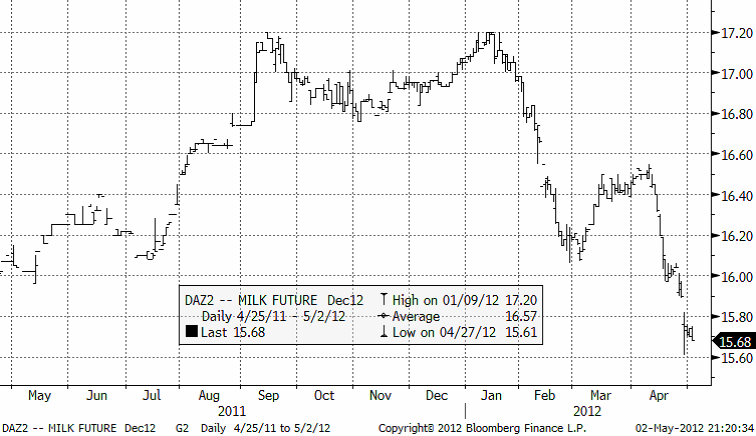Analys
SEB – Jordbruksprodukter, vecka 18 2012
 Sådden av majs går framåt mycket fort i USA. Nu är mer än hälften sått. Höstvetet är i mycket gott skick och det brukar leda till en stor skörd. På torsdag nästa vecka är det dags för WASDE-rapport igen. Den väntas vara ”bullish” sojabönor och ”bearish” vete och majs.
Sådden av majs går framåt mycket fort i USA. Nu är mer än hälften sått. Höstvetet är i mycket gott skick och det brukar leda till en stor skörd. På torsdag nästa vecka är det dags för WASDE-rapport igen. Den väntas vara ”bullish” sojabönor och ”bearish” vete och majs.
International Grains Council (IGC) skriver i sin senaste rapport att de globala marknaderna för spannmål och oljeväxter har påverkats kraftigt av en rad olika bedömningar av grödorna under april, där osäkerheten kring grödornas tillstånd har hjälpt till att upprätthålla en period av hög prisrörlighet.
Mestadels goda utsikter för den kommande amerikanska vete- och majsskörden tyngde marknaderna, medan resultaten var mer osäkra på andra håll och där det ogynnsamma vädrets effekter och dess påverkan på grödor i Europa och OSS fortfarande håller på att identifieras. Sojabönskomplexet har hållit sig fortsatt starkt allteftersom produktionsestimaten i Sydamerika successivt har justerats ned.
 För vete, har nedgången i priserna i USA framförallt triggats av gynnsamma växtförhållanden, men det negativa, ”bearish”, sentimentet har mildrats av nedjusteringar i prognoserna för EU’s produktion samt en stark efterfrågan på gammal skörd, speciellt till foder. Den kraftiga ökningen i majspriserna i slutet på förra månaden har urholkats av en ökad optimism över att nästa skörd i USA kommer att bli mycket stor. Nedjusterade estimat över produktionen av i Sydamerika har gett stöd och drivit sojabönsmarknaden högre, med frontkontraktet på CBOT som nu närmar sig 4-års högsta.
För vete, har nedgången i priserna i USA framförallt triggats av gynnsamma växtförhållanden, men det negativa, ”bearish”, sentimentet har mildrats av nedjusteringar i prognoserna för EU’s produktion samt en stark efterfrågan på gammal skörd, speciellt till foder. Den kraftiga ökningen i majspriserna i slutet på förra månaden har urholkats av en ökad optimism över att nästa skörd i USA kommer att bli mycket stor. Nedjusterade estimat över produktionen av i Sydamerika har gett stöd och drivit sojabönsmarknaden högre, med frontkontraktet på CBOT som nu närmar sig 4-års högsta.
Arealen för spannmål under 2012/13 förväntas öka med 1.6% till 539 miljoner hektar, den högsta på 16 år. Den totala vetearealen kommer sannolikt inte att förändras så mycket jämfört med 2011/12, medan arealen för majs och korn kommer att öka, framförallt i Nordamerika och OSS. Baserat på de senaste siffrorna över sådd areal och med hänsyn till visst bortfall av höstvete, justeras prognosen ned för spannmålsproduktionen under 2012/13 med 7 mt till 1 869 mt, vilket dock är en ökning med 1.5% sedan förra året. Veteproduktionen förväntas minska medan produktionen av majs, korn, durra, havre och råg förväntas öka. Den globala konsumtionen av spannmål beräknas öka med 1.5% jämfört med förra året, till rekordhöga 1865 mt, där användning av spannmål som foder beräknas stiga jämförelsevis snabbare än användningen till livsmedel eller till industriell bearbetning. En stigande efterfrågan på kött i utvecklingsländer förväntas vara en bidragande orsak till ökad användning av foder, men det kan däremot komma att bli ett litet skifte från vete till majs. Den globala efterfrågan på industriprodukter, såsom stärkelse, förväntas öka, medan efterfrågan från den amerikanska etanolsektorn kan komma att minska. Utgående lager i slutet på 2012/13 förväntas stiga något till 383 mt, en ökning för andra året i rad, och hos de största exportörerna förväntas den uppgå till 139 mt, främst pga högre amerikanska majslager.
Den globala handeln förväntas öka med 1% till 263 mt, till följd av ökad efterfrågan på kvarnvete och foder. Men en del av foderefterfrågan beräknas skifta tillbaka till majs, och handeln med den grödan förväntas stiga för fjärde året i rad – inklusive en ökad import till Kina – och en ökad konkurrens från majs förväntas begränsa den globala handeln med fodervete. Efter en stark ökning under 2011/12, förväntas inga större förändringar i handeln med korn.
Vi ser i ovanstående tabell, att IGC justerar upp utgående lager. Sammantaget är rapporten alltså ”bearish”.
CME förlänger öppettiderna för spannmåls- och oljeväxt-terminer och optioner. Nuvarande öppettider är från 18:00 – 07:15 och från 9:30 till 13:15 från söndag till måndag, Chicagotid. Från den 14 maj blir öppettiden på söndag till måndag från 17:00 till 16:00 och under måndag till fredag från 18:00 till 16:00. Det är alltså stängt bara två timmar varje dygn. Detta betyder också att det kommer att vara öppet för handel på CBOT när WASDE-rapporterna kommer. Tidigare var det bara Matif som var öppet.
Odlingsväder
UK Met Office förutspådde för drygt en månad sedan en onormalt torr aprilmånad, med allvarliga konsekvenser “…drought impacts in the coming months are virtually inevitable.” Sedan visade det sig att april blev den blötaste aprilmånaden på 100 år. Met Office har gjort sig känt för sina simuleringsmodeller körda genom en superdator som förbrukar lika mycket elektricitet som 1000 normala villor. Även solen har fläckar, som en del ”skeptiker” kanske skulle ha sagt. Så över till andra sidan jorden, till Australiens Met Office: ENSO-förhållandena är fortsatt normala. Southern Oscillation Index (SOI) har hållit sig mellan -7 och -8 den senaste veckan. SOI-värden mellan -8 och +8 indikerar neutrala ENSO-förhållanden.
ENSO går det faktiskt att göra tillförlitliga prognoser på, som sträcker sig upp till sex månader framåt i tiden. Dessa pekar, som vi tidigare sett, på neutrala förhållanden (bra) eller El Niño (bra). I Sydamerika förbereder man sig på att kunna inleda vårbruket om några månader under fuktiga och ideala förhållanden för att skapa en rekordskörd.
Vete
Matifvetet med novemberleverans har som stigit från 170 euro per ton i november till 201.75 euro nu, har tappat momentum i sprisuppgången. Stödet för uppåttrenden ligger nu strax under. Antingen bryts stödet eller så måste uppgången fortsätta. Med så mycket positiva nyheter om väder, stor areal för majs och crop conditions, vore det konstigt om priset fick för sig att stiga ytterligare.
Nedan ser vi Chicagovetet med leverans i december. Vi skrev för en vecka sedan att det tycks finnas ett tekniskt stöd på 650 cent. Att det nu hållit, kan möjligtvis tolkas som en något ”bullish” indikation.
Nedan ser vi hur terminspriserna på Matif och Chicago förändrats den senaste veckan. Det har varit obetydliga förändringar den senaste veckan. Contangot har ökat i Chicagovetet, men på Matif är det nästan ingen förändring alls.
Crop condition för höstvetet i USA, som rapporterades i måndags kväll klockan 22, ligger på 64% good / excellent. Ratings över 60% har (nästan) alltid lett fram till stora skördar.
IGC:s prognos för den globala vete produktionen under 2012/13 justeras ned med 5 mt till 676 mt, ungefär 19 mt lägre än förra årets estimerade rekordproduktion. Prognosen för EU sänks kraftigt på grund av rapporter om värre skador än väntat på Europas grödor som en följd av det kalla vädret i februari och den senaste tidens torka, som samtidigt som den lindras på kontinentens västra delar ökar som ett växande hot för grödorna i öster. Lägre skördar innebär också att prognosen för globala lager i slutet på 2012/13 justeras ned med 2 mt till 206 mt från den historiskt höga nivån 210 mt som förväntas uppnås i slutet på denna säsong.
Tillväxten inom livsmedel, industriell användning och ökat antal vete-baserade etanol anläggningar förväntas uppvägas av en minskad foderanvändning, men den totala globala konsumtionen förväntas endast visa en begränsad nedgång. Efter att ha nått en ny topp om 140 mt under föregående år, kan en minskad import till foder användning komma att minska den globala handeln med vete med ca 5 mt, men mycket kommer att bero på prisnivån för fodervete i förhållande till majs.
Den senaste prognos för 2012 års veteproduktion i OSS Europa från FAO ligger på 73.7 mt, en nedgång med ca 10 procent från förra årets rekordskörd och under genomsnittet för de senaste fem åren. Detta beror främst på dåliga utsikter för Ukraina, där en skarp nedgång i produktionen av vete väntas reflektera ogynnsamma förhållanden denna säsong: vissa större spannmålsproducerande delar av landet har drabbats hårt av torka sedan sådden förra hösten, samtidigt som utvintring har varit högre än normalt på grund av den stränga kylan i kombination med begränsat snötäcke. De värst drabbade områdena förväntas ersättas med andra grödor under våren. Med en kraftigt förväntad minskning av skördad areal och lägre avkastning förväntas produktionen av vete i Ukraina att uppgå till 14 mt, nästan 40 procent under förra årets rekordskörd och väl under genomsnittet de senaste fem åren.
I Ryssland däremot, pekar de senaste indikationerna på en marginell ökning av produktionen av vete under 2012 till följd av ökad sådd areal som ett svar på fortsatt höga priser. De flesta grödorna i Ryssland skyddades också av ett fullgott snötäcke under vintern. Den utvintring som drabbat vissa grödor förväntas vara genomsnittlig, trots perioder av sträng kyla. Utifrån ett antagande om normala förhållanden under resten av växtsäsongen förväntas produktionen uppgå till 56.8 mt, en ökning med ca 1 procent från förra årets skörd.
I Vitryssland är utsikterna också gynnsamma för årets veteproduktion, där vetet står för en fjärdedel av landets årliga spannmålsproduktion.
I Moldavien är utsikterna för höstvete och korn fortfarande osäkra på grund av torka i vissa delar av landet under hösten och sträng kyla under vintern. Sådden av majs förväntas öka under våren för att kompensera bortfallet av vete.
I Ryssland och Ukraina har exportpriserna på kvarnvete stigit med 13 procent under de senaste 4 månaderna, främst på grund av oro för det torra vädrets påverkan på 2012 års vete grödor i Ukraina. På dessa nuvarande nivåer är priserna fortfarande höga, trots ett fall under förra årets andra halva i samband med 2011 års skörd, och påverkar inhemska priser i importländer inom OSS regionen, i synnerhet Kaukasus-länderna som är starkt beroende av import av spannmål från Ryssland och Ukraina.
I OSS Asien är vete den huvudsakliga grödan. Kazakstan är den största producenten och merparten av grödan sås i april och maj. Sådden pågår nu för fullt i de södra regionerna och i mitten av april var 29 procent avklarad. Sådd areal beräknas officiellt till 13 500 hektar, en liten minskning mot föregående års nivå. Den siffran kan dock komma att minska ytterligare på grund av dålig jordfuktighet efter det torra vädret under hösten och otillräcklig med snö under vintern, framförallt i landets viktiga spannmålsproducerande centrala delar och vissa delar i norr, särskilt oblasterna Akmola, Karaganda och Pavlodar. Det slutliga utfallet kommer dock att bero på regn under de kommande månaderna. Minskad sådd i kombination med en återgång till en mer genomsnittlig avkastning efter förra årets höga nivåer, kommer sannolikt att resultera i en betydligt lägre produktion den här säsongen.
På andra håll i regionen visar tidiga prognoser att, trots en lång vinter, att spannmålsproduktionen kommer att öka från förra årets nivåer i nästan alla länder och särskilt i Armenien där spannmålsproduktionen beräknas bli 13 procent högre. Sammantaget så har spannmålsproduktionen under de senaste åren i Kaukasus länderna (Azerbajdzjan, Armenien och Georgien) fått politiskt stöd och gynnats av relativt goda väderförhållanden men trots detta är länderna starkt beroende av import av spannmål, främst vete.
ADAS rapporterar att Storbritanniens vetegrödor överlag är i ”mycket bra skick”, tack vare regnet under april. Svalare temperaturer fick grödornas tillväxt att avta något under samma månad och utvecklingen är nu ”normal” för denna tid på året jämfört med slutet av mars när grödorna låg långt före.
Maltkorn
Novemberkontraktet på maltkorn har fortsatt att inte röra sig mycket. Priset håller sig över 220 euro, en nivå som köpare tidigare tyckt varit ”för billigt”.
Tillståndet för Storbritanniens höstkorn är mycket bra enligt ADAS och sådden av vårkorn är klart till 96% och ser lovande ut. Nedan ser vi utvecklingen / takten i sådden av vårkorn i Storbritannen. Grön stapel är 2012. Som vi ser såddes det mesta i mars. Det fick sedan en ordentlig rotblöta och lite kallare väder i april.
Potatis
Potatispriset för leverans nästa år, steg oväntat idag. Den senaste veckan har priset stigit från 14 euro per deciton till 14.70 euro.
Majs
Priset på decembermajs har inte haft någon vidare fart nedåt efter andra besöket uppe på 550 cent. Vi noterar också stigande bottnar, som bildar ett stöd. Igår (onsdag) föll priset stadigt ner mot det här stödet. Det drar ihop sig till ett test av det de närmaste dagarna.
Den 27 april var sådden till 53% klar, vilket är en ökning från 28% för en vecka sedan.
Nedan ser vi hur långt sådden nått per i måndags i olika delstater i USA:
IGC skriver i sin nya rapport att en ökad sådd under 2012 förväntas bidra till att global majsproduktion ökar med 4% till 900 mt. Viktigaste faktorn bakom detta är större skördar i USA och Ukraina, den största producenten utanför USA.
Räknar man in de globala (små) majslagren som förväntas uppgå till 129 mt i slutet på innevarande säsong kan det globala utbudet komma att toppa 1 miljard ton för första gången någonsin, med tillhörande goda exportmöjligheter.
Även med en ökad foderanvändning kommer produktionen att vara tillräcklig för att utöka lagren till 3-års högsta på 135 mt, vilket inkluderar en återhämtning i USA. Ingen större förändring förväntas inom industriell användning på grund av minskad efterfrågan i den amerikanska etanolsektorn. Den globala handeln förväntas öka med 6%.
Sojabönor
Marknaden testade mycket riktigt 1400 cent igen i veckan som gick. Men därefter föll priserna tillbaka under onsdagen (igår). Priset ligger nu precis på stödlinjen. Om den bryts på nedsidan signaleras att den stigande trenden från botten i december är över. Detta återstår att se bekräftas.
Sådden går fort framåt i USA. Den 20 april var 12% sått i USA. Förra veckan var det 6%. Vi ser noteringarna i diagrammet nedan som med blå kvadrater. Hittills ser det tidigt och bra ut.
Till följd av ytterligare nedjusteringar i Sydamerika, estimerar IGC den globala produktionen av sojabönor för 2011/12 till 238.4 mt, en minskning med 11% från föregående års rekord. Efter en dramatisk tillväxt under tidigare år, förväntas den globala handeln med sojabönor att minska för andra året i rad, om än marginellt, eftersom ökad export till Asien – framförallt Kina – uppvägs av minskad import från andra länder, inklusive EU. Den globala handeln med sojamjöl förväntas öka med ungefär 1% till en historisk högsta nivå om 57.6 mt. Buenos Aires Grain Exchange har återigen sett över sin prognos för Argentinas produktion av sojabönor. De justerar ned den till 43 mt från förra veckans 44 mt, då torkan tidigare under säsongen har skadat grödorna och därmed minskat avkastningen. Nedan ser vi en tabell med de olika prognosmakarnas prognoser för skördarna i Argentina. USDA ligger nu högt, som vi nämnde förra veckan, och väntas justera ner Sydamerikas skörd, i WASDE-rapporten nästa vecka.
Raps
Priset på novemberterminen har stabiliserat sig strax under 480 euro per ton. Flera försök har gjorts att pressa priset över 480 euro, men säljare har kommit in varje gång.
Rapsproduktionen i EU är på väg att falla till ett 6-års lägsta på 17.6 mt under 2012 efter att de svåra väderförhållandena under vintern har skadat grödorna, och på så sätt ökat farhågorna för ett begränsat utbud samt gett priserna på oljeväxten en rejäl skjuts uppåt, enligt StrategieGrains. Den stränga kylan har skadat grödorna i flera EU-länder. Torkan i år samt svängningar i temperaturen under april kan ge upphov till ytterligare problem.
Den genomsnittliga avkastningen för årets skörd beräknas uppgå till 2.95 ton per hektar (2.85 ton 2011), men arealen förväntas falla till ett 6-års lägsta på 6 miljoner hektar, en minskning från 6.8 miljoner hektar förra året. OilWorld justerar också ned sin prognos ytterligare för EU’s raps produktion under 2012 till 18.21 mt mot den tidigare uppskattningen på 18.48 mt och jämfört med 19.1 mt under 2011. Imorgon torsdag lanserar Matif ytterligare en kontraktsmånad, november 2014, på raps. Både futures och optioner noteras.
Gris
Majkontraktet fick inte någon rekyl uppåt, utan fallet utlöste rena panikförsäljningen. Priset har nu på bara två månader fallit från nära 100 cent till 81 cent.
Nedan ser vi terminspriserna på Eurex i euro per kilo och på CME omräknat till euro per kilo. Vi ser att priserna ligger mycket lägre i USA. Det är framförallt de korta terminskontrakten i USA som fallit. En liten effekt av det amerikanska prisfallet har som vi ser flyttat över till Tyskland och påverkat majkontraktet på Eurex. Ytterligare prisfall i Europa ”borde” följa.
Mjölk
Mjölkpriset föll som för en vecka sedan hade fallit under 16 cent, fortsatte fallet i veckan och har nu temporärt i alla fall, stabiliserats på 15.50 ungefär. Senast betalt för decemberleverans är 15.68 cent per pund. Hittills i år har priset fallit från 17:20 cent till 15.68 cent.
För några dagar sedan var det en artikel i ATL om ”det höga mjölkpriset”. Det verkar som om dagspressen skriver om saker som hände i marknaden för flera månader sedan. Om några månader kanske vi får läsa en artikel om hur det låga mjölkpriset slagit. Vill man hänga med när det händer och innan andra fattar det, bör man kanske hellre läsa det här veckobrevet.
[box]SEB Veckobrev Veckans råvarukommentar är producerat av SEB Merchant Banking och publiceras i samarbete och med tillstånd på Råvarumarknaden.se[/box]
Disclaimer
The information in this document has been compiled by SEB Merchant Banking, a division within Skandinaviska Enskilda Banken AB (publ) (“SEB”).
Opinions contained in this report represent the bank’s present opinion only and are subject to change without notice. All information contained in this report has been compiled in good faith from sources believed to be reliable. However, no representation or warranty, expressed or implied, is made with respect to the completeness or accuracy of its contents and the information is not to be relied upon as authoritative. Anyone considering taking actions based upon the content of this document is urged to base his or her investment decisions upon such investigations as he or she deems necessary. This document is being provided as information only, and no specific actions are being solicited as a result of it; to the extent permitted by law, no liability whatsoever is accepted for any direct or consequential loss arising from use of this document or its contents.
About SEB
SEB is a public company incorporated in Stockholm, Sweden, with limited liability. It is a participant at major Nordic and other European Regulated Markets and Multilateral Trading Facilities (as well as some non-European equivalent markets) for trading in financial instruments, such as markets operated by NASDAQ OMX, NYSE Euronext, London Stock Exchange, Deutsche Börse, Swiss Exchanges, Turquoise and Chi-X. SEB is authorized and regulated by Finansinspektionen in Sweden; it is authorized and subject to limited regulation by the Financial Services Authority for the conduct of designated investment business in the UK, and is subject to the provisions of relevant regulators in all other jurisdictions where SEB conducts operations. SEB Merchant Banking. All rights reserved.
Analys
Tightening fundamentals – bullish inventories from DOE

The latest weekly report from the US DOE showed a substantial drawdown across key petroleum categories, adding more upside potential to the fundamental picture.

Commercial crude inventories (excl. SPR) fell by 5.8 million barrels, bringing total inventories down to 415.1 million barrels. Now sitting 11% below the five-year seasonal norm and placed in the lowest 2015-2022 range (see picture below).
Product inventories also tightened further last week. Gasoline inventories declined by 2.1 million barrels, with reductions seen in both finished gasoline and blending components. Current gasoline levels are about 3% below the five-year average for this time of year.
Among products, the most notable move came in diesel, where inventories dropped by almost 4.1 million barrels, deepening the deficit to around 20% below seasonal norms – continuing to underscore the persistent supply tightness in diesel markets.
The only area of inventory growth was in propane/propylene, which posted a significant 5.1-million-barrel build and now stands 9% above the five-year average.
Total commercial petroleum inventories (crude plus refined products) declined by 4.2 million barrels on the week, reinforcing the overall tightening of US crude and products.


Analys
Bombs to ”ceasefire” in hours – Brent below $70

A classic case of “buy the rumor, sell the news” played out in oil markets, as Brent crude has dropped sharply – down nearly USD 10 per barrel since yesterday evening – following Iran’s retaliatory strike on a U.S. air base in Qatar. The immediate reaction was: “That was it?” The strike followed a carefully calibrated, non-escalatory playbook, avoiding direct threats to energy infrastructure or disruption of shipping through the Strait of Hormuz – thus calming worst-case fears.

After Monday morning’s sharp spike to USD 81.4 per barrel, triggered by the U.S. bombing of Iranian nuclear facilities, oil prices drifted sideways in anticipation of a potential Iranian response. That response came with advance warning and caused limited physical damage. Early this morning, both the U.S. President and Iranian state media announced a ceasefire, effectively placing a lid on the immediate conflict risk – at least for now.
As a result, Brent crude has now fallen by a total of USD 12 from Monday’s peak, currently trading around USD 69 per barrel.
Looking beyond geopolitics, the market will now shift its focus to the upcoming OPEC+ meeting in early July. Saudi Arabia’s decision to increase output earlier this year – despite falling prices – has drawn renewed attention considering recent developments. Some suggest this was a response to U.S. pressure to offset potential Iranian supply losses.
However, consensus is that the move was driven more by internal OPEC+ dynamics. After years of curbing production to support prices, Riyadh had grown frustrated with quota-busting by several members (notably Kazakhstan). With Saudi Arabia cutting up to 2 million barrels per day – roughly 2% of global supply – returns were diminishing, and the risk of losing market share was rising. The production increase is widely seen as an effort to reassert leadership and restore discipline within the group.
That said, the FT recently stated that, the Saudis remain wary of past missteps. In 2018, Riyadh ramped up output at Trump’s request ahead of Iran sanctions, only to see prices collapse when the U.S. granted broad waivers – triggering oversupply. Officials have reportedly made it clear they don’t intend to repeat that mistake.
The recent visit by President Trump to Saudi Arabia, which included agreements on AI, defense, and nuclear cooperation, suggests a broader strategic alignment. This has fueled speculation about a quiet “pump-for-politics” deal behind recent production moves.
Looking ahead, oil prices have now retraced the entire rally sparked by the June 13 Israel–Iran escalation. This retreat provides more political and policy space for both the U.S. and Saudi Arabia. Specifically, it makes it easier for Riyadh to scale back its three recent production hikes of 411,000 barrels each, potentially returning to more moderate increases of 137,000 barrels for August and September.
In short: with no major loss of Iranian supply to the market, OPEC+ – led by Saudi Arabia – no longer needs to compensate for a disruption that hasn’t materialized, especially not to please the U.S. at the cost of its own market strategy. As the Saudis themselves have signaled, they are unlikely to repeat previous mistakes.
Conclusion: With Brent now in the high USD 60s, buying oil looks fundamentally justified. The geopolitical premium has deflated, but tensions between Israel and Iran remain unresolved – and the risk of missteps and renewed escalation still lingers. In fact, even this morning, reports have emerged of renewed missile fire despite the declared “truce.” The path forward may be calmer – but it is far from stable.
Analys
A muted price reaction. Market looks relaxed, but it is still on edge waiting for what Iran will do

Brent crossed the 80-line this morning but quickly fell back assigning limited probability for Iran choosing to close the Strait of Hormuz. Brent traded in a range of USD 70.56 – 79.04/b last week as the market fluctuated between ”Iran wants a deal” and ”US is about to attack Iran”. At the end of the week though, Donald Trump managed to convince markets (and probably also Iran) that he would make a decision within two weeks. I.e. no imminent attack. Previously when when he has talked about ”making a decision within two weeks” he has often ended up doing nothing in the end. The oil market relaxed as a result and the week ended at USD 77.01/b which is just USD 6/b above the year to date average of USD 71/b.

Brent jumped to USD 81.4/b this morning, the highest since mid-January, but then quickly fell back to a current price of USD 78.2/b which is only up 1.5% versus the close on Friday. As such the market is pricing a fairly low probability that Iran will actually close the Strait of Hormuz. Probably because it will hurt Iranian oil exports as well as the global oil market.
It was however all smoke and mirrors. Deception. The US attacked Iran on Saturday. The attack involved 125 warplanes, submarines and surface warships and 14 bunker buster bombs were dropped on Iranian nuclear sites including Fordow, Natanz and Isfahan. In response the Iranian Parliament voted in support of closing the Strait of Hormuz where some 17 mb of crude and products is transported to the global market every day plus significant volumes of LNG. This is however merely an advise to the Supreme leader Ayatollah Ali Khamenei and the Supreme National Security Council which sits with the final and actual decision.
No supply of oil is lost yet. It is about the risk of Iran closing the Strait of Hormuz or not. So far not a single drop of oil supply has been lost to the global market. The price at the moment is all about the assessed risk of loss of supply. Will Iran choose to choke of the Strait of Hormuz or not? That is the big question. It would be painful for US consumers, for Donald Trump’s voter base, for the global economy but also for Iran and its population which relies on oil exports and income from selling oil out of that Strait as well. As such it is not a no-brainer choice for Iran to close the Strait for oil exports. And looking at the il price this morning it is clear that the oil market doesn’t assign a very high probability of it happening. It is however probably well within the capability of Iran to close the Strait off with rockets, mines, air-drones and possibly sea-drones. Just look at how Ukraine has been able to control and damage the Russian Black Sea fleet.
What to do about the highly enriched uranium which has gone missing? While the US and Israel can celebrate their destruction of Iranian nuclear facilities they are also scratching their heads over what to do with the lost Iranian nuclear material. Iran had 408 kg of highly enriched uranium (IAEA). Almost weapons grade. Enough for some 10 nuclear warheads. It seems to have been transported out of Fordow before the attack this weekend.
The market is still on edge. USD 80-something/b seems sensible while we wait. The oil market reaction to this weekend’s events is very muted so far. The market is still on edge awaiting what Iran will do. Because Iran will do something. But what and when? An oil price of 80-something seems like a sensible level until something do happen.
-

 Nyheter3 veckor sedan
Nyheter3 veckor sedanStor uppsida i Lappland Guldprospekterings aktie enligt analys
-

 Nyheter4 veckor sedan
Nyheter4 veckor sedanBrookfield ska bygga ett AI-datacenter på hela 750 MW i Strängnäs
-

 Nyheter4 veckor sedan
Nyheter4 veckor sedanSommaren inleds med sol och varierande elpriser
-

 Nyheter4 veckor sedan
Nyheter4 veckor sedanOPEC+ ökar oljeproduktionen trots fallande priser
-

 Nyheter3 veckor sedan
Nyheter3 veckor sedanSilverpriset släpar efter guldets utveckling, har mer uppsida
-

 Analys4 veckor sedan
Analys4 veckor sedanBrent needs to fall to USD 58/b to make cheating unprofitable for Kazakhstan
-

 Nyheter4 veckor sedan
Nyheter4 veckor sedanTradingfirman XTX Markets bygger datacenter i finska Kajana för 1 miljard euro
-

 Nyheter2 veckor sedan
Nyheter2 veckor sedanUppgången i oljepriset planade ut under helgen


